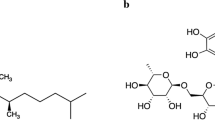Abstract
Nanoencapsulation is a process suitable for use in reducing degradation of instable components. In this study, chitosan and trimethyl chitosan with tripolyphosphate were used to nanoencapsulate vitamins C, B9, and B12. Analysis of the particle size showed that for a fix proportion of the polymer tripolyphosphate, the system showed a wide variation in size with the amount of added vitamins: e.g., for vitamin B9, the particle size varied from 150±5 nm to 809±150 nm. The zeta potential confirmed that trimethyl chitosan nanoparticles generally had a lower net positive charge (20 mV) than chitosan nanoparticles (40 mV). The encapsulation efficiency was found to be dependent on nanoparticle structure and vitamin solubility, with vitamin B9 the most efficiently encapsulated (approximately 40%). UV-Visible spectroscopy indicated different release profiles for vitamins C, B9, and B12 in a neutral PBS solution with release rates of 36%, 52%, and 16% after 2, 24, and 4 h, respectively. In conclusion the liberation was found to be slower in acidic media.

Similar content being viewed by others
References
W. Herrmann and R. Obeid, Vitamin in the Prevention of Human Diseases, De Gruyter, Berlin, 2011.
Report of a Joint FAO/WHO Expert Consultation, Vitamin and Mineral Requirements in Human Nutrition, World Health Organization, Bangkok, 2004.
A. K. Soliman, K. Jauncey, and R. J. Roberts, Aquaculture, 60, 73 (1987).
S. Abbas, C. Da Wei, K. Hayat, and X. M. Zhang, Food Rev. Int., 28, 343 (2012).
K. Jang and H. G. Lee, J. Agric. Food Chem., 56, 1936 (2008).
A. Alishahi, A. Mirvaghefi, M. R. Tehrani, H. Farahmand, S. A. Shojaosadati, F. A. Dorkoosh, and M. Z. Elsabee, Food Chem., 126, 935 (2011).
H. Madziva, K. Kailasapathy, and M. Phillips, J. Microencapsul., 22, 343 (2005).
A. Matsumoto, T. Kitazawa, J. Murata, Y. Horikiri, and H. Yamahara, J. Control. Release, 129, 223 (2008).
L.-M. Zhao, L.-E Shi, Z.-L. Zhang, J.-M. Chen, D.-D. Shi, J. Yang, and Z.-X. Tang, Braz. J. Chem. Eng., 28, 353 (2011).
J. W. Bae, D. H. Go, K. D. Park, and S. J. Lee, Macromol. Res., 14, 461 (2006).
M. Garcia-Fuentes and M. J. Alonso, J. Control. Release, 161, 496 (2012).
K. Y. Lee, Macromol. Res., 15, 195 (2007).
Y. Xu, Y. Du, R. Huang, and L. Gao, Biomaterials, 24, 5015 (2003).
B. Slütter and W. Jiskoot, J. Control. Release, 148, 117 (2010).
B. E. Benediktsdóttira, Ó. Baldurssonb, and M. Másson, J. Control. Release, 173, 18 (2014).
D. de Britto, M. R. Moura, F. A. Aouada, L. H. C. Mattoso, and O. B. G. Assis, Food Hydrocol., 27, 487 (2012).
D. de Britto, F. R. Frederico, and O. B. G. Assis, Polym. Int., 60, 910 (2011).
Q. Gan, T. Wang, C. Cochrane, and P. McCarron, Colloids Surf. B, 44, 65 (2005).
Y. Song, J. Zhou, Q. Li, Y. Guo, and L. Zhang, Macromol. Biosci., 9, 857 (2009).
A. Geçer, N. Yildiz, A. Çalimli, and B. Turan, Macromol. Res., 18, 986 (2010).
P. Gupta, K. Vermani, and S. Garg, Drug Discov. Today, 7, 569 (2002).
N. S. Patil, J. S. Dordick, and D. G. Rethwisch, Biomaterials, 17, 2343 (1996).
C. S. Brazel and N. A. Peppas, Polymer, 40, 3383 (1999).
X. Huang and C. S. Brazel, J. Control. Release, 73, 121 (2001).
Y. Cai and Y. Lapitsky, Colloids Surf. B, 115, 100 (2014).
in Fundamentals and Applications of Controlled Release Drug Delivery, J. Siepmann, R. A. Siegel, and M. J. Rathbone, Eds., Springer, London, 2012, Chap. 2.
C. Chen, J.-L. Zhou, X. Han, F. Song, X.-L. Wang, and Y.-Z. Wang, Nanotechnology, 25, 255101 (2014).
J. Siepmann and N. A. Peppas, Adv. Drug Deliv. Rev., 48, 139 (2001).
Author information
Authors and Affiliations
Corresponding author
Rights and permissions
About this article
Cite this article
de Britto, D., de Moura, M.R., Aouada, F.A. et al. Entrapment characteristics of hydrosoluble vitamins loaded into chitosan and N,N,N-trimethyl chitosan nanoparticles. Macromol. Res. 22, 1261–1267 (2014). https://doi.org/10.1007/s13233-014-2176-9
Received:
Revised:
Accepted:
Published:
Issue Date:
DOI: https://doi.org/10.1007/s13233-014-2176-9




